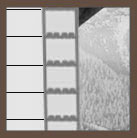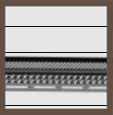Log House core features
The log house, the epitome of a timber house, has been providing people with safe and sturdy accommodation for thousands of years. Its key feature is always the solid walls made from solid wood boards.

The log house, the epitome of a timber house, has been providing people with safe and sturdy accommodation for thousands of years. Its key feature is always the solid walls made from solid wood boards.
The weak spot of many log house systems is airtight joining of the machined boards particularly in the corners. We have risen to this challenge and offer a unique corner joint which meets all the requirements of a modern building without additional caulking.
The double finger joint, and our “Tiroler Schloss” corner joint derived from it, reliably join the machined boards. Thanks to their special three-dimensional geometry, they prevent drafts and reliably transfer all loads occurring.
For a long time it was very expensive and time-consuming to seal a log house to make it airtight and prevent unpleasant drafts. Along with various sealants such as moss or newspaper, many manufacturers did and still do use large quantities of sealing compounds such as polyurethane foam.
Rather than working on the symptoms, we have gone right to the root of the problem. Our machined boards have several rows of tongues and grooves and thus prevent air from passing unhindered through the wall. To hold the joints between the logs together, the walls are joined using a special tension spring system. The tension spring system is so flexible that it does not prevent the boards from swelling and shrinking and works reliably even after many years.
We produce our log houses from 11" thick machined boards. In addition to aesthetic aspects, the wall thickness depends on its function in the house. The 4,7" thick machined board is therefore used mainly as internal walls. Machined boards above a thickness of 7,9" can already satisfy energy-saving requirements without any further insulation.
In addition to our native spruce boards, we also offer a variety of other wood types such as pine, Weymouth pine and larch; recently we also started supplying exclusive reclaimed wood surfaces.
PURE WOOD – NO FILM, NO INSULATION
With a wall thickness of 11" and our unique "double finger joint" corner joint, the Starkblock ensures a hard-wearing appearance and visual comfort. The double finger joint is not only elegant but also absolutely airtight. The machined boards are available in various types of wood such as spruce, larch, pine or Weymouth pine and surfaces such as planed, brushed or chopped. Solid wood construction in its most beautiful form for healthy living – for a whole lifetime!
We offer a wide range of possible surfaces.
Our log house walls do not require films of any kind due to our innovative timber joints. The machined boards are joined lengthways with special profiles. The corner joints we have developed are wedged together resisting shear. As a result our walls are airtight and capable of capillary diffusion!
Wood not only bears the loads originating from the roof and the upper floors but also serves as insulation at the same time! Due to the air trapped between the cells, the insulating capacity is many times higher than with bricks or even concrete.
Independent inspections of our company demonstrate the reliability of our work. The German Institute for Quality Assurance and Certification [RAL Deutsches Institut für Gütesicherung und Kennzeichnung e.V.] regularly inspects the production and assembly of our timber structures. Ongoing further development and high quality are very important to us. This is the reason that we are also members of the German Solid Wood and Log House Association [Deutscher Massivholz- und Blockhausverband]. Contact with other builders of log houses and the opportunity to drive forward innovations is one of our main aims.
 1
2
3
4
5
1
2
3
4
5





We only use native mountain woods. Our wood is harvested in the winter, air-dried for 1 year and then finally dried technically to 13%. All woods are free of heartwood and crack-free – for the highest quality requirements.
The most common tree species in Austria due to its natural distribution in the mountains. More than 50% of Austria's forest area is covered with spruce.
The pine is also known as the fir and is another major, native tree species used commercially with durable heartwood and good impregnability.
In addition to a large number of positive characteristics, the larch is also particularly decorative. Its color can range from reddish-yellow to bright red or even an intense red brown.
A reasonably priced alternative to the very expensive Swiss stone pine due to its similarity in appearance and smell to the Swiss stone pine. It is relatively lightweight and yet good to machine, impregnate and dry.